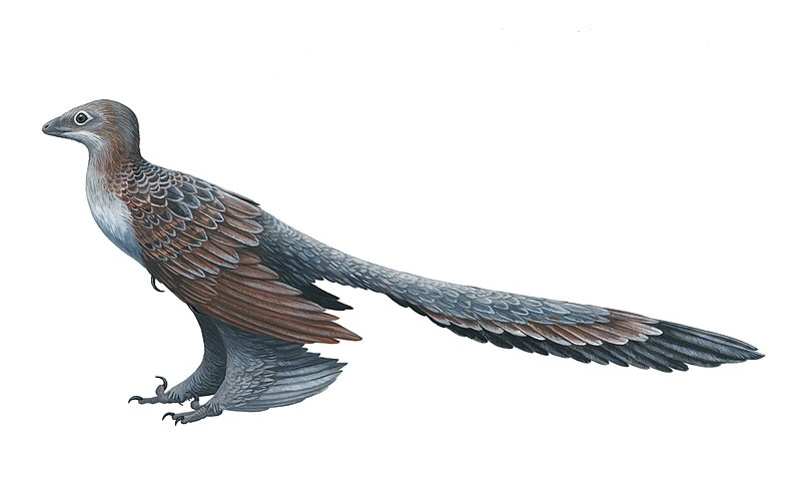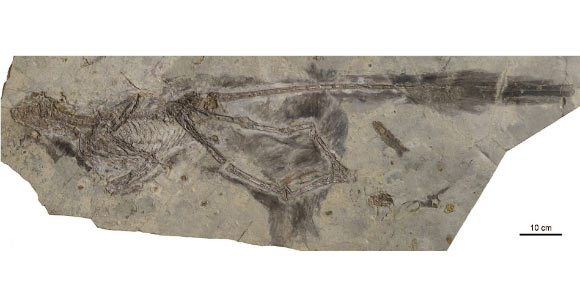Dive into the world of Changyuraptor, a creature that conjured images of a Cretaceous realm, soaring through the skies of the Early Cretaceous Period. Imagine, if you will, a time over 120 million years ago, when this fascinating being claimed the air as its domain. Unearthing the secrets of Changyuraptor not only enriches our understanding of the distant past but also sparks a sense of awe and curiosity about the natural world.
Changyuraptor, a name echoing the creature’s unique characteristics, was a winged marvel of its time. Its discovery in China’s lush, ancient landscapes offers a window into an era where dinosaurs ruled, and the skies whispered tales of evolution and survival. As we journey through this article, let’s unveil the story of this remarkable dinosaur, exploring its origins, lifestyle, and the mysteries it still holds.
Changyuraptor Key Facts
| Keyword | Fact |
|---|---|
| Pronunciation | Jyahng-Yoo-Rap-Tore |
| Meaning of name | Long Feathered Robber |
| Group | Theropoda |
| Type Species | Changyuraptor yangi |
| Diet | Carnivore |
| When it Lived | 125 to 113 MYA |
| Period | Early Cretaceous |
| Epoch | Aptian |
| Length | 3.9 feet |
| Height | Approximately 1.6 feet |
| Weight | 8.8 pounds |
| Mobility | Moved on two legs |
| First Discovery | 2012 by Local Farmers |
| Described by | 2014 by Gang Han, Luis M. Chiappe, Shu-An Ji, Michael Habib, Alan Turner, Anusuya Chinsamy, Xueling Liu and Lizhuo Han |
| Holotype | HG B016 |
| Location of first find | Yixian Formation, Jehol Biota, Liaoning Province, China |
Changyuraptor Origins, Taxonomy and Timeline
Changyuraptor, whose name aptly translates to ‘Long Feathered Robber’, is a testament to the diverse and remarkable world of theropods. The name, a blend of Chinese (“changyu”, long feather) and “raptor”, resonates with its striking appearance and predatory nature. This member of the Dromaeosaurid family paints a picture of a time when evolution experimented with forms and features, leading to a spectacular array of life forms.

Delving into its taxonomic classification, Changyuraptor belongs to the theropod group, a lineage renowned for their bird-like characteristics. This dinosaur is categorized within the Dromaeosaurid family, known for their agility and keen predatory instincts. Changyuraptor yangi, the type species, stands as a unique chapter in the evolutionary tale of these magnificent creatures.
The timeline of this dino spans a fascinating era in Earth’s history. It is dated from the Early Cretaceous Period, specifically from the Aptian, around 125 to 113million years ago. This epoch was a crucible of biodiversity, setting the stage for the emergence of myriad life forms.
Discovery & Fossil Evidence
The story of Changyuraptor’s discovery unfolds in the rich fossil beds of China’s Yixian Formation, located within the Jehol Biota. In 2012, the diligent efforts of local farmers unearthed a discovery that would add a new dimension to our understanding of past life. The Holotype HG B016, first described in 2014 by a team led by Gang Han, opened a window into a world long gone.

This discovery not only enriched the tapestry of our paleontological knowledge but also shed light on the diversity and adaptability of dino species. The preserved fossils, a blend of skeletal remains and feather imprints, offered unprecedented insights into the physical characteristics and lifestyle of Changyuraptor. While this find didn’t revolutionize our understanding of theropods, it certainly added a rich, detailed brushstroke to the evolving picture of dinosaur diversity.
Changyuraptor Size and Description
Changyuraptor yangi, an intriguing figure in the dino world, was endowed with a striking physique. Its long, feathered tail, a hallmark of the species, added to its aerial prowess. This dino’s anatomy – from its robust body and agile limbs to its streamlined head and neck – speaks of a creature adept at navigating the skies. The fossil evidence suggests a blend of terrestrial mobility and aerial agility, hinting at a fascinating lifestyle.
The size of Changyuraptor yangi remains a subject of ongoing research and debate. While the precise dimensions are yet to be confirmed, the fossil evidence suggests a creature of considerable size, especially for a flying dinosaur. The estimation of its weight and length continues to evolve as new discoveries and analyses emerge, painting a more comprehensive picture of this majestic creature.
The Dinosaur in Detail
Changyuraptor yangi, a unique player in the Cretaceous world, possessed several distinctive features that set it apart from its contemporaries. Its elongated tail feathers, among the longest known in the Theropoda, suggest a specialized adaptation, possibly for maneuverability or balance in flight. The interplay of these features underscores the dinosaur’s adaptability and survival instincts in a dynamic ecosystem.
Remarkably, Changyuraptor was not just a product of its environment but also an influencer. Its physical attributes, such as the clawed hands and feet, speak of a predatory lifestyle, hinting at its role atop the food chain. This dinosaur’s presence in the fossil record illuminates the complex interplay of evolution, adaptation, and survival strategies in the ancient world.
Contemporary Dinosaurs
In the age when Changyuraptor soared through the ancient skies, it shared the world with a myriad of other fascinating creatures, each playing a unique role in the tapestry of Early Cretaceous life. Let us embark on a journey through time to explore the dynamic interactions and relationships between Changyuraptor and its contemporaries – Psittacosaurus and Suzhousaurus.
Psittacosaurus, a small, herbivorous dinosaur, wandered the underbrush, its parrot-like beak nibbling on the foliage. While much smaller than our feathered predator, this dinosaur played a crucial role in the ecosystem, perhaps serving as potential prey for Changyuraptor. One can imagine the stealth and agility required by Changyuraptor to hunt these swift and alert herbivores.
Suzhousaurus, another contemporary, was larger, a herbivore of considerable size. It ambled through the same ancient forests, but its larger size meant it was less likely to be preyed upon by Changyuraptor. However, the presence of such sizable herbivores in the ecosystem would have influenced Changyuraptor’s hunting patterns, perhaps steering it towards smaller, more manageable targets like Psittacosaurus.
This ancient world, a mosaic of predators and prey, herbivores and carnivores, showcases the intricate web of life that Changyuraptor navigated daily. In this dance of survival, each species contributed to the story of life in the Early Cretaceous, a story where Changyuraptor was but one of many remarkable characters.
Interesting Points about Changyuraptor
- Changyuraptor boasted one of the longest tails among all known feathered dinosaurs, a distinctive feature that likely played a crucial role in its aerial abilities.
- The discovery of Changyuraptor in the rich fossil beds of the Yixian Formation adds a vital piece to the puzzle of dinosaur evolution, particularly in understanding the development of flight in theropods.
- Its impressive size, for a flying dinosaur, challenges our perceptions of the physical limits of flight.
- The fossil evidence of Changyuraptor provides invaluable insights into the diversity of feathered dinosaurs and their adaptations for flight.
- This dinosaur’s place in the ecological landscape of the Early Cretaceous Period offers clues about predator-prey dynamics and biodiversity during that epoch.
Changyuraptor in its Natural Habitat
Imagine the world of the Early Cretaceous, a period marked by vast and diverse landscapes, from dense forests to sprawling wetlands. The climate, fluctuating and dynamic, shaped an environment teeming with life. In this ancient theater, Changyuraptor yangi emerged as a carnivorous predator, navigating a realm filled with potential prey and competitors.
This dino’s ability to move both on land and in the air hints at a versatile lifestyle. As a carnivore, it likely preyed on smaller animals, using its keen senses and physical agility to secure meals. The social behavior of Changyuraptor remains a subject of speculation, but its adaptations suggest a creature well-equipped for survival in a competitive ecosystem.
The impact of Changyuraptor on its surroundings extends beyond its immediate survival needs. As a top predator, it played a role in shaping the ecological balance, influencing both the landscape and the evolutionary pathways of other species. The fossil record, a window into this ancient world, continues to reveal the intricate connections that defined life during the Early Cretaceous.
Frequently Asked Questions
Changyuraptor lived during the Early Cretaceous Period, approximately 125 to 113 million years ago.
As a carnivore, Changyuraptor likely preyed on smaller animals in its environment.
It was first discovered in the Yixian Formation, Jehol Biota, in Liaoning Province, China, by local farmers in 2012.
Changyuraptor moved on two legs and was also capable of flight, thanks to its feathered wings and tail.
Changyuraptor was first described in 2014 by a team led by Gang Han.
Its elongated tail feathers, among the longest known in feathered dinosaurs, and its considerable size for a flying species are distinctive features.
Sources
The information in this article is based on various sources, drawing on scientific research, fossil evidence, and expert analysis. The aim is to provide a comprehensive and accurate overview of Changyuraptor. However, please be aware that our understanding of dinosaurs and their world is constantly evolving as new discoveries are made.
This article was last fact checked: Joey Arboleda, 03-12-2024
